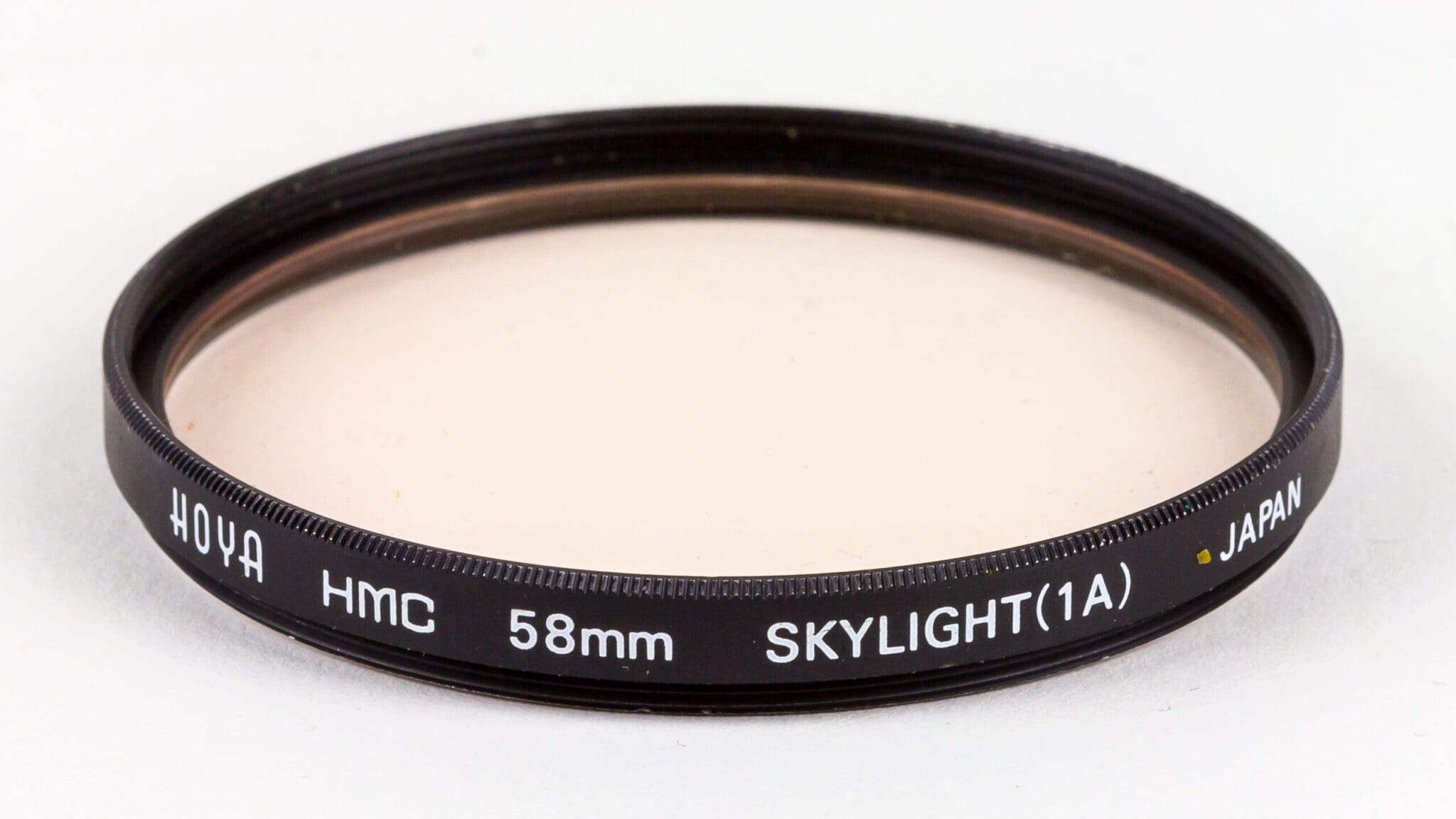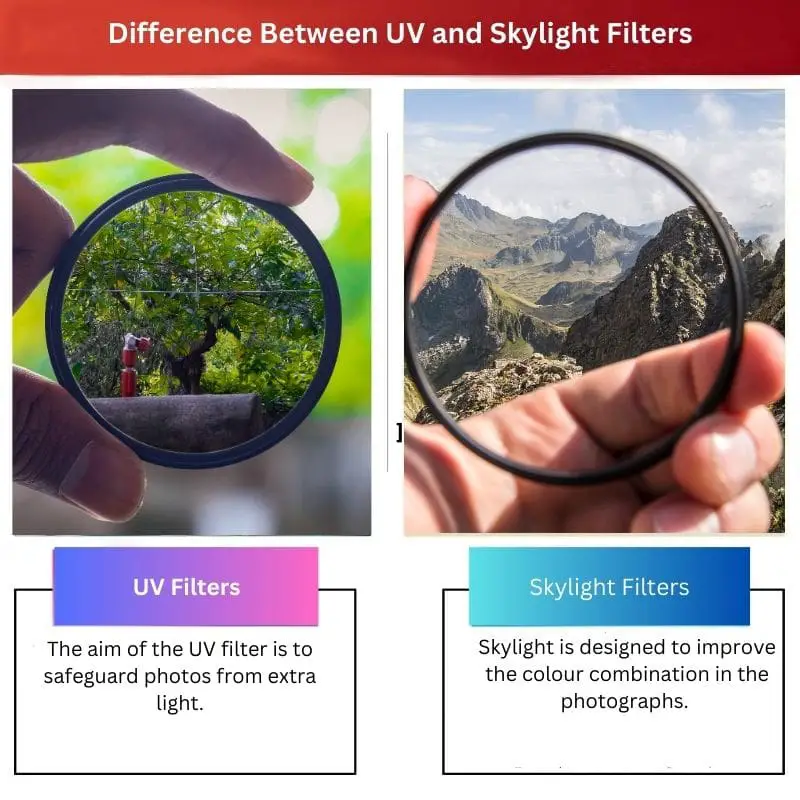Many outside supports are needed to capture something in the best possible way. One of those needs is proper lighting.
And to control the lighting, professional photographers use many filters, UV filters and skylight filters are two such filters that help to control the light while taking photographs.
Key Takeaways
- UV filters block ultraviolet light, protecting the camera sensor and reducing haze in outdoor photography.
- Skylight filters have a slight pink tint, reducing the blue cast from natural light in color film photography.
- Both filters provide additional lens protection, but UV filters are more widely used in the digital era due to their broader utility.
UV Filters vs Skylight Filters
UV filters are designed to block ultraviolet (UV) light from entering the camera lens. A UV filter can be used to reduce these unwanted effects and produce clearer and sharper images. Skylight filters are designed to reduce the blueish cast that can be present in outdoor photography.

UV filter has existed for a long time now, but it entered the field of photography when digital photography started to become mainstream.
UV filters are plain glass, and it eliminates the extra light while clicking pictures. Mostly for black and white pictures, UV filters get used.
Skylight filters are nothing new but UV filters with a slightly orange-coloured lens. These are mainly designed for capturing landscape photos.
It can hold many colours at once, and its tinged glass offers a warm tone in the photographs. It got widely used in the shooting of analogue films.
Comparison Table
| Parameters of Comparison | UV Filters | Skylight Filters |
|---|---|---|
| Objective | The aim of the UV filter is to safeguard photos from extra light. | Skylight is designed to improve the colour combination in the photographs. |
| Colour | UV filters do not have any colours in them. | The skylight filter has a warm hue, a reddish-orange colour. |
| Form | It is clear glass and nothing else. | It is dyed with a tinged colour. |
| Purpose | It is specifically designed for photography. | It was exclusively meant for the shooting of analogue films. |
| Best suited for | For digital photography, UV filters are ideal. | For the analogue shoot, skylight filters are the best suit. |
What are UV Filters?
UV filters are made to block UV or ultraviolet light. The most popular use of UV filters can be seen in the making of sunscreens that are meant to protect skin from damaging UV rays of the sun.
However, another very popular use of UV filters can be found in the field of photography. These UV filters came to work after the emergence of the digital camera era.
UV filters get coated on the glass discs, which are supposed to get over the lenses of the camera.
UV filters are plain glass without any colour added. Being free from any added colour, it is open to providing a wide range of colour spectrums.
As these filters block the UV rays, it is capable of restricting extra light from getting captured in the frame. Its use in black-and-white pictures is very common. Its characteristic of eliminating extra light gives the photograph a proper contrast.
Not only do they capture the perfect picture lighting, but the UV filters can also protect the camera lenses from getting distorted and contaminated by the ultraviolet sun rays.
They also take care of shade optical elements. UV filters are getting utilized in photography for the sake of digital photography.

What are Skylight Filters?
A skylight filter is a slightly tinged filter that adds a warm appeal to the photographs. The hue that these filters retain is orangish.
This filter is ideal if you want to give your photographs a warm feel. This filter is a type of UV filter with a reddish or orange hue.
The main purpose of this filter is to maintain all a colour of a picture. So when you are looking to capture a very colourful background or landscape, then this filter will help to retain the contrast of all the existing colours.
For landscape photos, a skylight filter should get chosen, but when it comes to portraits, a skylight filter will be a terrible choice. The reflection of this filter on any skin tone is not good at all.
There is a reason behind the warm hue of this filter. With the popularity of colour film and transparency film, photographers came across a problem that is a bluish hue that gave the pictures a cold look.
To get rid of this situation, a reddish filter got made, and that is known as a skylight filter.

Main Differences Between UV and Skylight Filters
- UV filter works to stop the excess light of the background from ruining the picture and protects the photo so that it does not get affected by the extra light. On the other hand, skylight filters are designed to correct the colour combination in the photographs.
- UV filter retains no colour of its own, but the skylight filter has a warm hue present in it. The colour can be categorized as pinkish-orange.
- A UV filter is a clear glass, while a skylight is just a UV filter with the tinged look of dyed colour.
- The UV filter is specifically designed for digital photography, whereas skylight filters are exclusively meant for shooting analogue films.
- UV filters are subjected to get widely used for black-and-white photographs. As UV filters restrict the light from entering, the contrast of the picture stays balanced. And skylight filters, on the other hand, are able to maintain the colours, so they are best for nature photography.

- https://journals.biologists.com/jeb/article-abstract/146/1/63/5373
- https://www.tandfonline.com/doi/abs/10.1179/019713689806046156

This is such a comical article! UV filters sound like plain glass without any added color, whereas the skylight filters seem to have a warm, orangish tint. I can picture the photographers choosing between ‘warm appeal’ and ‘extra light protection.’
It is interesting how UV filters are used for digital photography, while the skylight filters are better suited for analog photography.
The post is really interesting. I think UV filters are better suited than skylight filters for general photography, while the skylight filters are best for specific scenarios.
I completely agree with you Sabrina34, I found the part about the differences between UV and skylight filters particularly interesting.
I think the information provided in this post is very useful for photographers.
I agree with you Scarlett Thompson. The article is informative and well-written.
The article is very informative, but I would argue that the positive effects that UV filters have on photographs make them better suited for general use. I think the skylight filters should be used in specific scenarios chosen wisely.
I would have to disagree with you Ken, I actually found the comparison table very useful. It really helped me see the main differences between UV and skylight filters.
I am glad I found this post. the information about UV and skylight filters is clearer after reading it.